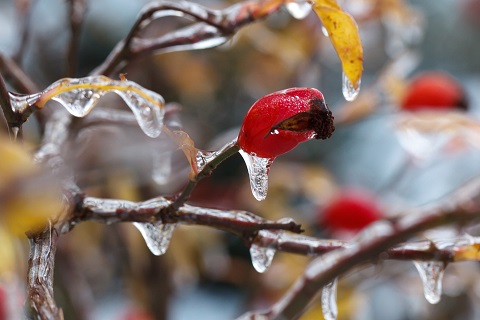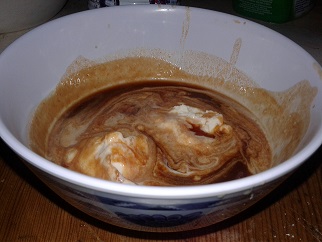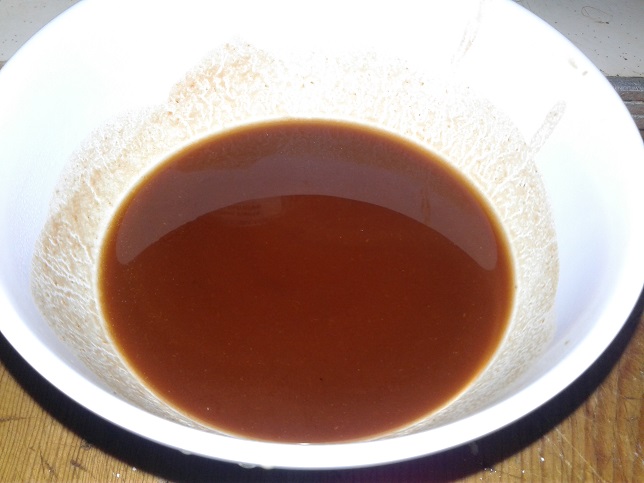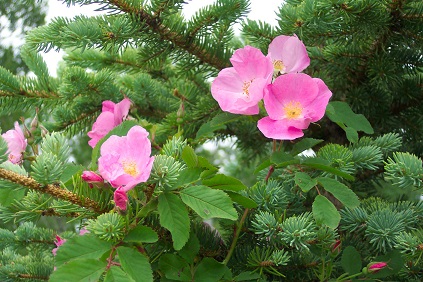Clalufaen
Elves would probably not survive space travel without "roseblood," which is rosehip soup
With a mostly vegetarian diet, and a greater need for proper vitamins than many other species, avoiding scurvy has always been a challenge for elven starhands, and also elves in cold climates with long snowy periods in winter. Fortunately, the elves are creative and resourceful. Nor are they generally satisfied with subsistence living; they want their food to taste good, not just be good for them.
Granted, some elves genuinely enjoy the spruce liquor that is occasionally added to the tot for long periods in the Void, but to most, it is a necessary evil. Oranges and other citrus fruits are not always available, and notoriously difficult to preserve while maintaining their nourishing qualities -- a challenge that has stymied sailors in many cultures.
But the elves have discovered a marvelous secret: rosehip soup.
In a way, rosehip soup (or clalufaen /'klæ.lu:.feɪn/, "Roseblood," as the elves call it,) is a stereotypical elven food. First, who else would think of the best way to eat the products of flowers? Second, gathering and processing them requires both a keen observation of seasonal changes, and the patience to spend a lot of time on an exacting and somewhat tedious task.
Rosehips can be made into a variety of foods, including jellies, sauces, seasoning, pastry filling, and even fruit leather, and the elves use them for all of these things. There will probably be more elven rosehip recipes forthcoming, but today, we will concentrate on this ubiquitous part of elven starfaring life.
 Rosehips, also called rose haws, are the orange-red (or occasionally, purple or black) fruits of roses that grow in the late summer and fall, after pollinated roses have dropped their petals. They are shiny and about the size of marbles. Their texture should be firm and hard, a bit like a melon rind. They can be difficult to distinguish from the haws of hawthorns2 when both bushes are bare in the winter months, so it's best to know which plant is which prior to the frost, if both grow in the area.
Wild rugosa roses are said to produce the tastiest rosehips, and they're certainly among the largest and most abundant rosehip producers of all the rose species, but any rosehip can be used. Generally the bigger they are, the less sweet and more watery, so the biggest ones may be unsuitable to products like syrup and pie fillings. They're probably sufficient for our purposes, however.
Elves know not to pick rosehips that grow in urban areas if possible, particularly in places where toxins are common, such as Gnomish steamworks, dockyards, dyers, tanners and gunpowder manufacturers. Rosehips can easily pick up those toxins and they are not destroyed by processing.
The best time to pick rosehips is after the first frost that singes the leaves, which sweetens the fruits, but before they freeze solid, which damages their quality and integrity. They should still be firm to the touch and have good colour. Traditionally, elves leave the shriveled and dried ones for the birds, both for the sake of sustainability in their ecosystems, and because they aren't as tasty. If the hips are completely ripe, they will come free from the stem easily, but they can also be clipped or cut free. Often gloves and thick clothing are used to avoid being scratched by the thorns. You'll need about twice as many fresh hips as you would dried ones.
Rosehips, also called rose haws, are the orange-red (or occasionally, purple or black) fruits of roses that grow in the late summer and fall, after pollinated roses have dropped their petals. They are shiny and about the size of marbles. Their texture should be firm and hard, a bit like a melon rind. They can be difficult to distinguish from the haws of hawthorns2 when both bushes are bare in the winter months, so it's best to know which plant is which prior to the frost, if both grow in the area.
Wild rugosa roses are said to produce the tastiest rosehips, and they're certainly among the largest and most abundant rosehip producers of all the rose species, but any rosehip can be used. Generally the bigger they are, the less sweet and more watery, so the biggest ones may be unsuitable to products like syrup and pie fillings. They're probably sufficient for our purposes, however.
Elves know not to pick rosehips that grow in urban areas if possible, particularly in places where toxins are common, such as Gnomish steamworks, dockyards, dyers, tanners and gunpowder manufacturers. Rosehips can easily pick up those toxins and they are not destroyed by processing.
The best time to pick rosehips is after the first frost that singes the leaves, which sweetens the fruits, but before they freeze solid, which damages their quality and integrity. They should still be firm to the touch and have good colour. Traditionally, elves leave the shriveled and dried ones for the birds, both for the sake of sustainability in their ecosystems, and because they aren't as tasty. If the hips are completely ripe, they will come free from the stem easily, but they can also be clipped or cut free. Often gloves and thick clothing are used to avoid being scratched by the thorns. You'll need about twice as many fresh hips as you would dried ones.
 The end result looks a bit like tomato soup. I found it to have a full, rich flavour that was something like tomato sauce, and something like a raspberry and strawberry puree, so imagine those blended together. Delicious!
It also has a similar texture to tomato sauce, and is somewhat tart. Traditionally the elves add sweetener, preferably maple syrup, but sometimes honey when maple syrup is unavailable. They almost never use processed sugar, as the practice of sugar harvesting is usually exploitative (although there are exceptions, such as Tohvassneris.) I found that about a teaspoon or two of sweetener to a bowl of soup was an ideal ratio, and I personally found maple syrup to be vastly superior to honey for this purpose.
Some recipes call for various mulling spices, such as cinnamon, cloves, or nutmeg, but most elves don't bother with such additions, and I personally believe it diminishes, rather than improves, the soup.
Often the texture and tartness of clalufaen is cut with heavy cream, whipped cream, or ice cream when possible. It may also be eaten with soured cream or plain (or slightly sweetened) yogurt. Note that their traditional soured cream is not the same thing as North American sour cream, but is somewhat closer to condensed milk in texture -- what Europeans might call crème fraîche. Still, I imagine sour cream would work just fine.
Often it is served with a crisp cookie, especially when creams are unavailable, which is common on long voyages. It may be served hot or cold, and so ship's cooks often prepare large batches and seal it in jars prior to entering a wormhole. I found it equally tasty regardless of temperature. Heated, it's a warming, nourishing soup, and cooled, it's a rich, flavourful treat. Enjoy!
The end result looks a bit like tomato soup. I found it to have a full, rich flavour that was something like tomato sauce, and something like a raspberry and strawberry puree, so imagine those blended together. Delicious!
It also has a similar texture to tomato sauce, and is somewhat tart. Traditionally the elves add sweetener, preferably maple syrup, but sometimes honey when maple syrup is unavailable. They almost never use processed sugar, as the practice of sugar harvesting is usually exploitative (although there are exceptions, such as Tohvassneris.) I found that about a teaspoon or two of sweetener to a bowl of soup was an ideal ratio, and I personally found maple syrup to be vastly superior to honey for this purpose.
Some recipes call for various mulling spices, such as cinnamon, cloves, or nutmeg, but most elves don't bother with such additions, and I personally believe it diminishes, rather than improves, the soup.
Often the texture and tartness of clalufaen is cut with heavy cream, whipped cream, or ice cream when possible. It may also be eaten with soured cream or plain (or slightly sweetened) yogurt. Note that their traditional soured cream is not the same thing as North American sour cream, but is somewhat closer to condensed milk in texture -- what Europeans might call crème fraîche. Still, I imagine sour cream would work just fine.
Often it is served with a crisp cookie, especially when creams are unavailable, which is common on long voyages. It may be served hot or cold, and so ship's cooks often prepare large batches and seal it in jars prior to entering a wormhole. I found it equally tasty regardless of temperature. Heated, it's a warming, nourishing soup, and cooled, it's a rich, flavourful treat. Enjoy!
Harvesting & Preparing Rosehips
If you want to gather and process your own fresh rosehips, these are the steps to follow. Certainly this is the best way to get the most vitamins out of them, as much of their vitamin content is destroyed by the drying process. I chose to start with dried rosehips1 myself, for three reasons. First, it's more authentic to this Avalonian Imperial Navy staple. Fresh rosehips just wither, go moldy and rot on a long voyage, so the Navy is in the habit of purchasing dried rosehips from their protectorates and client communities; which also helps to put some money into local elven economies. Second, it's just a lot quicker and easier to work with dried rosehips. The third reason I went with dried fruits was observational: the birds had stripped most of the rosebushes in my immediate area this winter when I went out to look for some. I figured that if any were left, the birds needed them more.Selecting Your Rosehips

Ice on Wild Rose by Petr Kratochvil
Processing
To process the rosehips, trim off the shriveled blossoms and stems. Then cut each rosehip open and scoop out the seeds, which can have coats of hair that taste bitter and can irritate the mouth and throat. Rinse them afterwards to remove stray seeds and dirt. Afterwards, the fresh rosehips can be used right away, or they can be dried. Rosehips are dried by placing the halves on a screen in direct, dry air. Elves use cool ovens, warm rocks, or their hearths for this. You'll need to make sure they reach a temperature of 110 °F (44 °C) in your oven or dehydrator. Dry them until they're hard and brittle. Store in an airtight jar.Preparation:
If using dried rosehips, soak 2 cups of them in 2 cups of cold water for at least 2 hours. Some elven gourmands will advise you to leave them soaking overnight. They should be thoroughly softened. If using fresh rosehips, skip this step. Pour everything into a pot and heat. Add 2 more cups of cold water (or 2 to 4 cups, if you started with fresh fruits) and bring to a boil. Cook for 20-30 minutes on low heat to concentrate the liquid. Allow the mixture to cool completely, which takes at least half an hour. Strain through a fine sieve or cheesecloth to remove any stray seeds and husks. Dispose of them. You'll now have a dull red fruit puree. Add 2-4 cups more cold water to your puree, according to desired consistency3, and simmer for about 10 minutes, stirring occasionally. You'll begin to see a thick fruit sauce forming on the edges of the pot as the water diminishes, which looks a bit like tomato sauce if you started with red-orange rosehips. While you're simmering, whisk your cornstarch and the same amount of cold water together into a paste. Add slowly to your pot until it reaches the consistency you prefer.Serving:

Rosehip Soup with Ice Cream by Diane Morrison
Don't forget that you can click on the blue compass on the left to access the Table of Contents at any time!

Want to read all of the Toy Soldier Saga fiction, even before the rest of the world does?Subscribe now!
Ingredients:
- 2 cups (473 ml) dried rosehips, or 4 cups (946 ml) fresh rosehips
- 6-8 cups (1.4 to 1.9 litres) cold water
- 1 tbsp (15 ml) cold water
- 1 tbsp (15 ml) corn starch
- 1/4 to 1/2 tsp (1.25 to 2.5 ml) each cinnamon, nutmeg, cloves, or other mulling spices (optional)
- Heavy cream, whipped cream, vanilla ice cream, crème fraîche, or Greek yogurt (optional)
- Maple syrup or honey to taste
Wild Roses in Pine by Kim Newberg
A wild rugosa rose entwined in a pine tree.
It was amazing how many things were required to feed the crew of a dreadnaught! First there came the dried provisions: waybread, dried fruits, peas and beans, dried rosehips and spruce needles to prevent scurvy, pemmican and cornbread (innovations of the wood elves borrowed by the Avalonian Imperial Navy) ; and these in scores of enormous wooden crates.
Footnotes:
- Dried rosehips can often be found in bulk in local herbal stores, but you can often get them as rosehip tea in supermarkets. Just break them out of their bags and use them as directed. Or you could always try putting a whole bunch of teabags in to make your first puree, and squeeze out the bags from there!
- Hawthorn is used to treat blood pressure ailments, congestive heart failure, and a variety of heart ailments. It can potentially be dangerous to people with low blood pressure in large doses, and probably isn't helpful in the cold because it lowers blood pressure, so I wouldn't advise making pots of soup out of the haws!
- Finding the right consistency is a matter of personal preference, and is more art than science. I suggest starting with less water rather than more water, as you can always add more at any stage and just simmer things a little longer if you're not happy. But even if you've overdone the water, all is not lost! If you're patient, just keep simmering until it cooks down, and if you're not, you can often make it up at the end by just adding more blended cornstarch. It's a very forgiving recipe! Just don't let it scorch, and you're good to go.





Comments